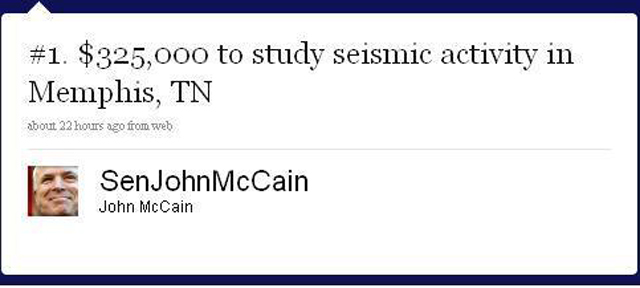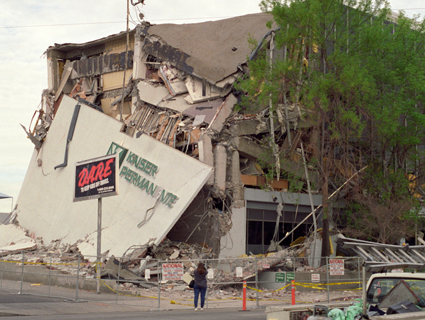With many DC residents still cowering nervously under our desks after yesterday’s earthquake, Dave Weigel flags a rather regrettable tweet from Sen. John McCain from 2009. (Regrettable Tweets from John McCain is good Tumblr idea, come to think of it.) McCain has a habit of going on Twitter sprees, in which he rattles off a long list of earmarks that he considers to be prima facie ludicrous. Like this one:
 The punchline is that this is a terrible waste of money because everyone knows Memphis doesn’t even have earthquakes.
The punchline is that this is a terrible waste of money because everyone knows Memphis doesn’t even have earthquakes.
But actually, the punchline here is John McCain, who is blissfully ignorant of the fact that Memphis, Tennessee actually does sit on top of a major fault line, the New Madrid Seismic Zone. There haven’t been any major earthquakes on the New Madrid fault since the winter of 1811–1812 (when there were four), but FEMA believes that a serious earthquake in Memphis “is likely to constitute the highest economic losses due to a natural disaster in the United States,” due to the impact it would have on interstate commerce, agriculture, and property damage. It would displace about up to 7 million people and could cause hundreds of billions of dollars in damage. A FEMA-commissioned study, meanwhile, showed that the likelihood of a magnitude 6 or 7 earthquake occuring along the New Madrid fault in the next 50 years was 90 percent. There are also 15 nuclear power plants within the New Madrid Seismic Zone. If a major earthquake were to happen there, it would go “way beyond Katrina” in terms of devastation, as one senior Department of Defense official put it, according to Wired.
As it happens, there’s a debate within the seismological community about just how much of a threat there is of an earthquake in the Midwest. A Northwestern University professor I spoke with in April believes that the fault may have shut off, in which case spending money on earthquake readiness would be a bad investment. What’s at stake? Billions of dollars in long-term costs (shoring up all federal buildings, for instance) as well as harder-to-calculate economic costs to communities along the fault. Folks in Paducah, Kentucky say the threat of a major earthquake there has made it harder to lure new businesses. With so much hinging on the science, investing in research right now may actually be a very cost-effective approach.
The larger issue here is that McCain and plenty of other lawmakers have sought to make the case that earmarks are by definition wasteful, as part of their crusade against government spending. But earmarks have about the same degree of usefulness as any other form of non-earmarked funding. In reality, it’s not the earmarks themselves that McCain should be concerned with; it’s the process by which they’re allocated.












